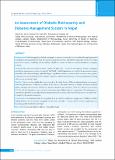Please use this identifier to cite or link to this item:
https://hdl.handle.net/20.500.14356/1706Full metadata record
| DC Field | Value | Language |
|---|---|---|
| dc.contributor.author | Mishra, S K | - |
| dc.contributor.author | Jha, N | - |
| dc.contributor.author | Shankar, P R | - |
| dc.contributor.author | Dahal, P K | - |
| dc.contributor.author | Khatiwada, B | - |
| dc.contributor.author | Sapkota, Y D | - |
| dc.date.accessioned | 2023-05-19T05:28:57Z | - |
| dc.date.available | 2023-05-19T05:28:57Z | - |
| dc.date.issued | 2016 | - |
| dc.identifier.citation | MishraS. K., JhaN., ShankarP. R., DahalP. K., KhatiwadaB., & SapkotaY. D. (2016). An Assessment of Diabetic Retinopathy and Diabetes Management System in Nepal. Journal of Nepal Health Research Council, 14(2). https://doi.org/10.33314/jnhrc.v14i2.798 | en_US |
| dc.identifier.issn | Print ISSN: 1727-5482; Online ISSN: 1999-6217 | - |
| dc.identifier.uri | http://103.69.126.140:8080/handle/20.500.14356/1706 | - |
| dc.description | Original Article | en_US |
| dc.description.abstract | Abstract Background: Visual damage due to diabetic retinopathy is a major concern which can be reduced through appropriate coordination and cooperation between the diabetes management services and diabetic retinopathy services. The study assessed the existence, availability and accessibility of health care services for diabetes mellitus and diabetic retinopathy in Nepal. Methods: The study was carried out from 1 April to 24 June 2015. The tool for assessment of diabetic retinopathy and diabetes management systems developed by the World Health Organization was used for the assessment of major stakeholders like endocrinologists, ophthalmologists, ophthalmic assistants, nurses involved in diabetes care, patients and human resources from Ministry of Health and Population and international non-governmental organizations dealing with eye care services in Nepal. Results: Thirty-seven key stakeholders were selected for the study. Six out of fifteen ophthalmologists were unaware about the prioritization of diabetes as national health concern. The main function of diabetes association included patient education and awareness 18(48.6%), clinician education and awareness 16(43.2%). Thirteen professionals (35.1%) said that the patients were not found to be aware about diabetic patients’ organizations. The information to community is provided occasionally and only through national-level media. All forms of diabetes care were funded out-of-pocket by the patients themselves. Conclusions: Coordination should be strengthened for an effective and holistic management of diabetes mellitus making diabetes care and diabetic retinopathy services more accessible. Diabetes mellitus and its complications are becoming a public health threat in Nepal. Keywords: Assessment; diabetes; diabetes retinopathy; Nepal. | en_US |
| dc.language.iso | en | en_US |
| dc.publisher | Nepal Health Research Council | en_US |
| dc.relation.ispartofseries | May-Aug, 2016;798 | - |
| dc.subject | Assessment | en_US |
| dc.subject | Diabetes | en_US |
| dc.subject | Diabetes retinopathy | en_US |
| dc.subject | Nepal | en_US |
| dc.title | An Assessment of Diabetic Retinopathy and Diabetes Management System in Nepal | en_US |
| dc.type | Journal Article | en_US |
| local.journal.category | Original Article | - |
| Appears in Collections: | Vol. 14 No. 2 Issue 33 May-Aug 2016 | |
Files in This Item:
| File | Description | Size | Format | |
|---|---|---|---|---|
| 798-Article Text-1476-2-10-20170528.pdf | Fulltext Download | 161.09 kB | Adobe PDF |  View/Open |
Items in DSpace are protected by copyright, with all rights reserved, unless otherwise indicated.
